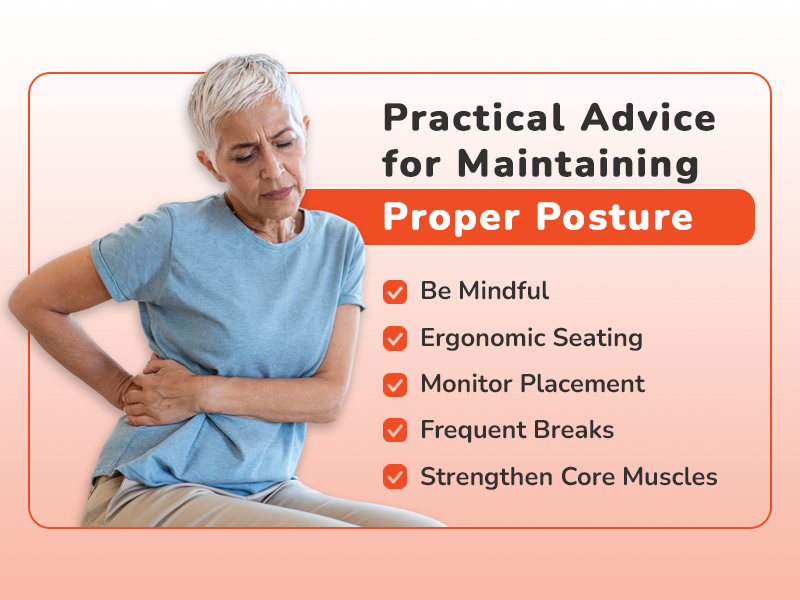Back Support Solutions: Improving Posture and Reducing Pain in Daily Living
Maintaining good posture and preventing back pain are essential for a healthy and comfortable daily life. In this comprehensive article, we will delve deep into the world of back support solutions, providing you with valuable insights and practical tips on how to improve your posture, reduce pain, and elevate your overall well-being. Your journey to a healthier, more comfortable life begins here as we explore the various options, benefits, and strategies available to support your back and enhance your daily experience.
The Importance of Good Posture
When it comes to your health and well-being, proper posture is a cornerstone that should never be overlooked. In this section, we delve into the significance of maintaining good posture and explore how it contributes to your overall health and quality of life.
Understanding the Significance of Proper Posture
Proper posture goes beyond merely standing or sitting up straight; it is about aligning your body in a way that minimizes stress on your muscles, joints, and ligaments. It’s the art of maintaining a balanced and symmetrical position that allows your body to function optimally.
How Good Posture Contributes to Overall Health
The benefits of good posture extend far beyond the aesthetics of appearing more confident and poised. Here’s how it positively impacts your overall health:
- Spinal Health: Good posture ensures that your spine is correctly aligned, reducing the risk of spinal issues and conditions such as scoliosis and herniated discs. It supports the natural curvature of your spine and helps distribute the forces of gravity evenly.
- Muscle and Joint Health: Proper alignment eases the strain on your muscles, preventing tension and discomfort. It also reduces the risk of chronic musculoskeletal problems, such as back, neck, and shoulder pain. Joints are less likely to become misaligned, leading to a decreased risk of arthritis and related issues.
- Improved Breathing: Maintaining an upright posture allows your lungs to expand fully, enhancing your breathing capacity. This, in turn, ensures efficient oxygen intake and improved lung function, benefiting your overall health.
- Digestive Health: Good posture aids in proper digestion by ensuring that your internal organs are not compressed or displaced. It can prevent issues like acid reflux and constipation.
- Enhanced Circulation: Proper posture promotes healthy blood circulation throughout your body, reducing the risk of circulatory problems, including varicose veins and deep vein thrombosis.
Types of Back Support Solutions
The world of back support solutions is rich and diverse, offering a wide array of options to cater to various needs and preferences. In this section, we will explore the range of back support solutions available and guide you on choosing the right one to meet your specific requirements.
Exploring a Range of Back Support Options
- Lumbar Support Cushions: Lumbar support cushions are designed to provide additional support to the lower back, particularly the lumbar region. They are often portable and can be used on various seating surfaces, including chairs and car seats. These cushions promote proper spine alignment while sitting.
- Ergonomic Chairs: Ergonomic chairs are specially designed to support the natural curvature of the spine. They offer adjustable features such as lumbar support, seat height, and armrests, allowing you to customize the chair to your body’s needs. Using an ergonomic chair at work or home can significantly enhance your posture and comfort.
- Posture Correctors: Posture correctors are wearable devices that gently remind you to maintain good posture. They are designed to pull your shoulders back and align your spine correctly. These devices are particularly beneficial for individuals who spend long hours at a desk or have a tendency to slouch.
- Back Support Belts: Back support belts, also known as back braces, are designed to provide extra support to the entire back, including the lumbar and thoracic regions. They are commonly used by individuals involved in heavy lifting or physically demanding jobs to prevent back injuries.
- Mattresses and Pillows: Investing in a supportive mattress and pillows is essential for maintaining proper spinal alignment during sleep. Mattresses with good lumbar support and ergonomic pillows can help alleviate back pain and promote restful sleep.
Choosing the Right Support for Your Needs
Selecting the right back support solution depends on your specific needs and lifestyle. Here are some considerations to help you make an informed choice:

- Identify Your Pain or Discomfort: Determine the areas of your back that require support. Is it your lower back, upper back, or both? Understanding the source of your discomfort will guide your selection.
- Evaluate Your Daily Activities: Consider your daily routine and activities. Do you spend long hours sitting at a desk, driving, or engaging in physical labor? Your choice of back support should align with the activities you perform regularly.
- Consult a Healthcare Professional: If you have chronic back issues or specific medical conditions, consult with a healthcare provider or physical therapist. They can offer personalized recommendations based on your condition.
- Test Before You Invest: Whenever possible, try out different back support solutions to determine which one provides the most comfort and relief. Sit in ergonomic chairs, wear posture correctors, and test various lumbar support cushions to find the best fit.
Benefits of Back Support Solutions
Back support solutions offer a multitude of benefits that go beyond mere comfort. In this section, we will explore these advantages, highlighting how these solutions can alleviate back pain and discomfort while simultaneously improving spinal alignment and posture.
Alleviating Back Pain and Discomfort
- Targeted Support: Back support solutions are designed to provide targeted assistance to the areas of your back that need it most. Whether you suffer from lower back pain, upper back discomfort, or lumbar issues, there is a specific support solution tailored to your needs.
- Reduced Muscle Strain: By promoting proper spinal alignment, these supports help reduce muscle strain and tension. This can be particularly beneficial for individuals who spend extended periods in seated positions or engage in physically demanding activities.
- Pain Management: Back support solutions serve as an effective means of pain management. Whether you have chronic back pain or occasional discomfort, these supports can significantly alleviate your symptoms, allowing you to lead a more comfortable and pain-free life.
- Enhanced Comfort: Comfort is paramount when it comes to back support. These solutions are crafted with ergonomics in mind, ensuring that you can go about your daily activities with ease and without the hindrance of persistent back pain.
Improving Spinal Alignment and Posture
- Spine Health: Maintaining proper spinal alignment is crucial for long-term spine health. Back support solutions aid in achieving and sustaining this alignment, reducing the risk of spinal issues and related conditions.
- Posture Correction: If you struggle with poor posture, back support solutions act as your silent reminder to stand or sit up straight. They help correct slouching and encourage a more upright and healthy posture.
- Enhanced Confidence: Good posture not only contributes to physical health but also boosts your confidence. When you stand tall and carry yourself with grace, you exude self-assuredness and project a positive image to those around you.
- Preventative Measure: Even if you don’t currently experience back pain, incorporating back support into your daily routine can serve as a preventative measure. It reduces the risk of future issues by maintaining the integrity of your spine and muscles.
- Improved Breathing and Circulation: Proper spinal alignment enhances lung capacity, leading to improved breathing. Additionally, it ensures unimpeded blood circulation, benefiting your overall health.
Tips for Achieving Better Posture
Maintaining proper posture is essential for overall health and comfort. In this section, we provide practical advice on how to achieve and sustain good posture. We also explore the importance of incorporating posture-friendly habits into your daily routine.
Read More: Understanding Hip Braces: Essential Insights for Pain Relief and Support
Practical Advice for Maintaining Proper Posture

- Be Mindful: Awareness is the first step to better posture. Pay attention to your body’s positioning, especially when sitting or standing for extended periods. Correct any slouching or hunching as soon as you notice it.
- Ergonomic Seating: Invest in ergonomic chairs and seating options that provide lumbar support and encourage a natural curve in your spine. Ensure that your feet are flat on the floor, and your knees are at a 90-degree angle.
- Monitor Placement: Position your computer monitor at eye level to prevent tilting your head up or down. This helps maintain a neutral neck position and reduces strain.
- Frequent Breaks: If you work at a desk, take regular breaks to stand, stretch, and walk around. Set a timer to remind yourself to move and readjust your posture.
- Strengthen Core Muscles: A strong core provides better support for your spine. Incorporate core-strengthening exercises into your fitness routine to help maintain proper posture.
Incorporating Posture-Friendly Habits into Your Daily Routine
- Phone and Screen Usage: Hold your phone or tablet at eye level to prevent neck strain. When using screens, maintain good posture by sitting up straight.
- Sleeping Position: Choose a mattress and pillows that support your spine’s natural alignment during sleep. Avoid sleeping on your stomach, which can strain your neck and back.
- Proper Lifting Techniques: When lifting heavy objects, use your legs, not your back. Bend at the knees and keep the object close to your body to avoid unnecessary strain.
- Footwear Matters: Wear shoes that provide proper arch support and cushioning. Good footwear can impact your overall posture and comfort.
Ergonomics in Daily Life
- Adjustable Workstations: If possible, invest in a height-adjustable desk that allows you to switch between sitting and standing positions throughout the day. This promotes movement and better posture.
- Keyboard and Mouse Placement: Position your keyboard and mouse at a height that allows your wrists to remain in a neutral position. Avoid excessive bending or reaching.
- Proper Lighting: Ensure that your workspace is well-lit to reduce eye strain and encourage better posture. Adjust lighting to minimize glare on screens.
- Chair Ergonomics: Select chairs that support the natural curve of your spine and offer adjustable features. Armrests and lumbar support are valuable additions for maintaining comfort and posture.
- Monitor Positioning: Keep your computer monitor at eye level and approximately arm’s length away. Adjust the screen angle to reduce glare and encourage a comfortable viewing posture.
Conclusion
Incorporating back support solutions into your daily life can be a game-changer, offering a path to better posture, reduced pain, and enhanced comfort. By understanding the importance of good posture, exploring the available options, and implementing practical tips, you can take significant steps toward a healthier, pain-free back. Say goodbye to discomfort and hello to a life filled with better posture and reduced back pain.

